Sarah Hepola's Blog, page 3
May 4, 2020
All My Friends Are Gonna Be Strangers
On Saturday I went to the most popular mall in Dallas, and I wrote this piece. I hadn’t planned to report on my state’s controversial re-opening, but I was overwhelmed by the oddness of the spectacle and the unprecedented nature of the moment. When I posted the story to Facebook, my college best friend commented, “So it was like a Twilight Zone episode.” And I responded, “Yeah, a Twilight Zone episode staged on a set where I bought a bubble skirt in the Eighties.”
There’s a Larry McMurtry novel that is also a Merle Haggard song called “All My Friends Are Gonna Be Strangers.” I always loved that title. I found it memorable and beguiling: What did it mean? How could friends become strangers? The line floats to mind whenever I see a once-dear store or restaurant gutted and renovated, an experience I often have in Dallas, a city of constant renovation, a city of tall cranes and crafty developers. I have no idea what the future holds for NorthPark. Is it going away? Will it come back? I don’t know these things. But walking around those barren halls on Saturday afternoon brought a sadness for a lost world and an uncertain future. I won’t ramble here; you can read the piece to hear more of my thoughts. But I felt the need to share a few snapshots from my strange voyage.
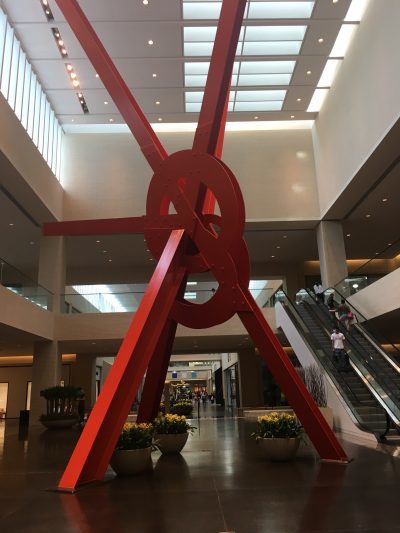
People have long been saying malls are dead. The truth was a bit more nuanced. Many malls were dead, especially the ones that looked like the rest of them, but NorthPark was considered a success story, a mall that lived past the “mall era.”
NorthPark Mall is owned by the Nashers, a family of art collectors in Dallas that also give their name to Nasher Sculpture Center, a world-class collection of modern art. The museum is filled with curious artifacts like this enormous orange … protractor? I’ve never known what to call this thing, but it is one of the many flourishes that make the place different. In factchecking Ray Nasher to make sure I had all that correct, I was reminded of this: “At the time of its construction, [NorthPark] was the largest climate-controlled, indoor building in the world.” Texas: We make malls!
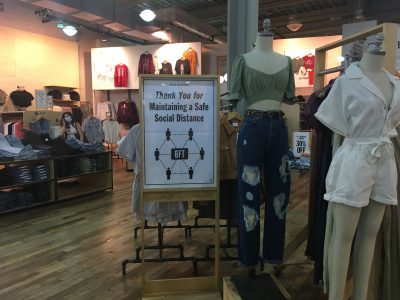
Social distancing signs were all over, and everyone wore face masks. Customers weren’t allowed to use the dressing rooms here at Urban Outfitters, but it was still the most crowded store I entered on Saturday, since I didn’t check out whatever had a crowd lining up at the Finish Line.
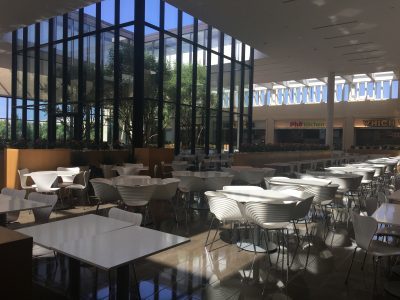
The food court looked like it was set up for a party that never arrived. When I took this photo, I was struck by the prettiness of the place. Is there a phrase that conveys more aesthetic bankruptcy than “food court?” (Maybe: Strip mall.) It evokes those bland Eighties atriums flanked by Orange Julius and Burger King, but the food court at NorthPark has natural lighting and actual trees growing in the middle. It is an artificial environment, yes, but damn it works hard not to rub our noses in that.
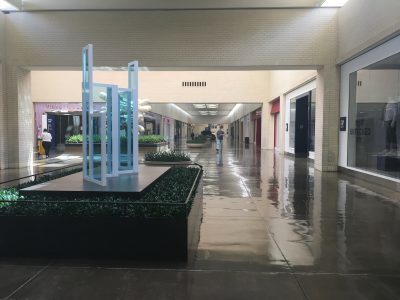
This gives you a sense of how empty the place was. Real empty.

AMC declared bankruptcy in mid-April, and Neiman-Marcus a few days later, and when I read this NYT piece, it was the first time I realized NorthPark Mall might be going away. Movies at the mall were one of my happiest childhood memories. My dad took me most weekends, and I got to pick the film, which for a younger sibling was like having the power to change the weather.
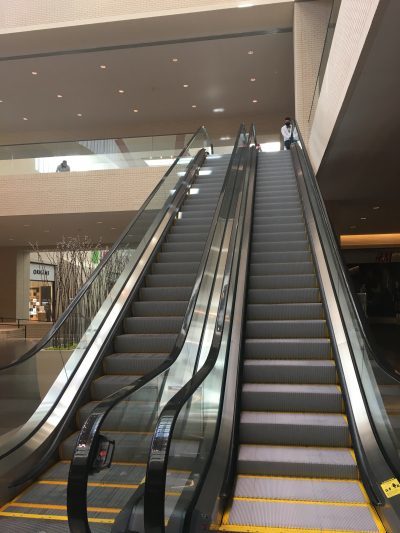
Escalators were invented in the late 19th century, but for me, the escalator was invented when I first went to a mall as a little girl and discovered that stairs could move. I was obsessed with escalators. Who wasn’t? The fear of getting caught in them. The fantasy of taking them up, up, up into the clouds. They were so visually dazzling, so richly metaphoric. Moving while standing still. I will forever associate escalators with malls, and riding this empty one on my way toward the exit doors of NorthPark on Saturday felt ominous. That guy standing at the top in a tuxedo shirt and a face mask had been hired to — I don’t know. Make sure people were OK on the escalators, I guess. But as I stood at the bottom and turned up to take a photo, I already felt like I was taking a snapshot of the past.
The post All My Friends Are Gonna Be Strangers appeared first on Sarah Hepola.
April 6, 2020
Someone to Love
I was driving the long solitary highway to Alaska when the guy in the passenger seat asked if I knew Fountains of Wayne. Was that a statue? Was that a waterfall? It was a band, he explained, named after a store in New Jersey. That guy was not my boyfriend, but I hadn’t given up yet. I kept studying him, trying to find the secret door. He unsheathed a silver disc from an enormous CD binder and held it by the hole in the center, like his index finger was wearing a sombrero.
“See if you recognize this song,” he said, and slid the disc into the player, and a kick drum launched the beat. Are you alone now? the singer asked.
I did recognize the song. “Radiation Vibe.” It was catchy and generic in that way of pop radio. Baby baby. Come on, what’s wrong? It was opaque in that way of pop lyrics. What was a “radiation vibe”, anyway? Was it good? Was it bad? I’d never given the song much thought. It was wallpaper from 1996, hooky and hummable. More than five years had passed since then, but I could still sing the chorus. It was easy. Shine on, shine on, shine on.
We listened to the entire album. The guy’s CD binder contained a hundred discs, and our plan was to listen to every one, because that’s how long it takes to drive to Alaska and that’s how much I wanted to learn him. Pop music had once been a private pleasure, a little girl making swirls in the red shag carpet of her bedroom as she danced to Prince and Michael and Whitney, but as I grew older, and more love-doped, I saw the way pop music could grant you access to boys. Knowing the right bands might make you the right girl.
That guy liked to pantomime the songs as I drove, a karaoke performance for one. I can still see him next to me pointing out the windshield of my Honda Accord and then into the sky as he lip-synced the next song, “Sink to the Bottom”:
Cars on the highway, planes in the air. Everyone else is going somewhere.
The verse struck me, because it was the opposite of our situation. There were no cars on the highway, since we were on a 1200-mile stretch of asphalt so desolate it sometimes felt like driving on Mars. There were no planes in the air, since we were in remote British Columbia. We looked up to find jay birds and woodpeckers and hawks we mistook for eagles. I liked the self-pity of the last line — everyone else is going somewhere — because it’s how I felt in my younger years, watching high school and college friends jet off to Europe and ski resorts and exotic beaches as I stayed grounded in Texas, but now I was twenty-eight, and I was finally in motion. I was in the midst of a five-month solo road trip around the country, camping in national parks and crashing on friends’ couches, and it had been the guy’s idea to join me for a two-week jaunt. He flew into Seattle so we could hit the Al-Can Highway to Fairbanks, and I happily agreed to this plan, because a) who doesn’t want to go to Alaska? but also b) What if this was the secret door?
The guy drew my attention to track seven, a song called “Sick Day.” Many songs have a fade-out, the guy explained, but this song had a fade-IN. He turned up the volume so I could savor the slow crescendo of the kick and the snare, like the sun sneaking onto the horizon. “Sick Day” wasn’t as chipper as the earlier songs, so eager to sink their hooks in you; it had a laid-back melancholy.
Check out the girl in the Harbor Tunnel.
Crawling to work, six feet under
And the day has just begun. They’re all chewing gum
And laughing at the voice on the cracking radio station
Lead us not into Penn Station
Cause the best part’s just begun.
We’re all becoming one. Again.
I didn’t know much about songwriting, but I knew about storytelling, and damn. This was a world summoned in a few couplets. It captured the ache of being alone together on that highway, one of the central sadnesses of modern life at the turn of the century. We had not yet learned the alone-togetherness of the internet, of social media, of sexting. Well, I hadn’t anyway. My mind snagged on the crisp sonic detail of “the crackling radio station.” The pun on the Lord’s prayer, clever and irreverent at once. But what sunk me was that one line. “We’re all becoming one. Again.” Part deliverance, part depression. I imagined the mid-size sedans and the hulking SUVs and the honking taxi cabs fighting for position, locked in battle but forced to get along.
I was not yet familiar with the New York commute. I’d never heard that phrase “bridge-and-tunnel crowd,” but I liked how the song took as its subject the mundane routine of ordinary life. There were lines about coffee creamer, a copy machine, a cubicle. Pop songs tend toward the exceptional: The wildest nights and the hottest women. But this song was quietly observant and minor note. There was a line that nearly made me gasp. She’s a hell of a girl, she’s alone in the world. Maybe it felt like that line had been written for me.
This ability to elevate suburban details into memorable pop music is what I think of when I think of Fountains of Wayne. The band came from New Jersey, a place people have deeply mixed feelings about, and as someone who comes from Texas, I relate. I liked how the songs, sung by guitarist Chris Collinsworth but written by bassist Adam Schlesinger, offered the texture of life in another town. A childhood of laser shows and strip malls, a trip on the Acela train, traffic on I-95. Later I would learn Schlesinger was influenced by the Kinks writing about London, and Springsteen’s Born to Run, but I was at the age where I wanted to write about important places, part of why I was taking that extravagant road trip, and I liked being reminded that places become important because we write about them. That small lives matter.
The guy never became my boyfriend. Of course he didn’t. He flew back to Texas, and I kept driving, but now I was listening to Fountains of Wayne. It was good driving music. Funny, silly, singable. I drove down into the Badlands and up along the ribboning roads of blue-sky Montana, out to the craggy black-rock shores of Maine, I drove with my windows down and my shoes kicked onto the floorboard, I liked to find unusual harmony parts; it felt less like singing alone.
I moved back to Texas. I got a real-live boyfriend. He wanted me to settle down with him, which confused me, since I’d become accustomed to straining. The third Fountains of Wayne album Welcome Interstate Managers came out the next year, and it was a hit, and I felt ahead-of-the-curve in a way I rarely did with pop music. The breakout hit was “Stacy’s Mom.” It was an ear worm with a comic punch, a teen boy fantasizing about his friend’s hot mother, a conceit that felt very of-the-moment even as the tune had a dose of 80s nostalgia, The Cars meets Fast Times at Ridgemont High.
It bothers me a little that a band I loved so deeply will be remembered for the MILF song. Over the years, this is how people identify Fountains of Wayne when I ask if they know them. “Oh they wrote that song about MILFs?” Yes, it’s true, but also other things. There are better songs on that album, more intricate jewel boxes. The blue-collar pining of “Hackensack”:
I used to work in a record store, now I work for my dad,
Scraping the paint off the hardwood floor, the hours are pretty bad.
The tragic collapsed narratives of “Mexican Wine”:
She lived alone in a small apartment
Across the street from the health department
She left her pills in the glove compartment
That was the afternoon her heart went
Novelistic. That’s what the critics called it. But to me, they were like Edward Hopper paintings or Raymond Carver short stories set to 4/4 time. And yet the legacy of the album, and the band, is something like “Stacy’s Mom has got it goin’ on.” Look, it’s a good MILF song. It’s funny and snappy, and it captured a shifting attitude toward middle-aged women that would become screamingly apparent to me when I got on the dating apps in my forties and discovered half my suitors were in their twenties. The Mrs. Robinson dynamic is nothing new, of course. But something was happening in the early aughts — porn, American Pie, Pilates and Juicy Couture, Demi Moore and Ashton Kutcher — to inspire that Fountains of Wayne anthem, and to push a media conversation about older women (the cougar: term of empowerment or objectification? debate in the comments!), and it removed any stigma that young men felt for fantasizing about older women. The strange fact that I was rejected by twenty-something men in my twenties and pursued by them in my forties? This is a story for another time.
I interviewed Adam Schlesinger once. I’d moved to Brooklyn, and I was single again. I lived in a rambling shotgun apartment where I smoked Parliament Lights out my kitchen window underneath a wooden placard I bought at Office Depot that read, “No Smoking.” I wrote freelance articles for a website that ran Q&As with cool musicians. Fountains of Wayne had a new album called Traffic & Weather. I can’t find the interview on Google anymore; the website folded. They told us the internet was forever, but it’s subject to the same brutal forces that carved the rest of civilization. Empires burn, neighborhoods crumble. The best story that’s every been written will disappear in a flash of coding, and somebody’s stupid Geocities page could last till the end of time. Anyway I’m glad the interview is gone. I don’t think it was very good; I was nervous and fan-girly. I remember talking about New York news anchors Chuck Scarborough and Sue Simmons. The album’s title track imagined a sizzling sexual interplay between them off-camera, and we got a good laugh out of the way the mind invents stories, latches on to billboards and strangers in bodegas and talking heads on a TV screen, all the ways the human animal seeks a companion for its lonely cage.
The single from the album was “Somebody to Love.” A little on the nose, that title, but what can I say? It spoke to me. I once heard a musician describe pop music as all about cars and girls, but it was never about either for me. Pop music was about someone to love. The ache of not finding that person, the ache of finding that person and realizing they were the wrong person. I was singing along to those songs, not just because my voice needed expression but because my soul sought harmony. I was dancing to those songs, not just because my legs needed movement but because my body sought rhythm with another body.
I was in line at a sidewalk counter on Lower Greenville in East Dallas when I heard Adam Schlesinger died. It was April 2, 2020, two weeks into the global pandemic re-shaping our world in real time. I was standing six feet from other people in line, waiting to place my order, when my brother texted me. I tapped a link that took me to the news that Schlesinger died of coronavirus at 52. I felt dizzy, like I might fall over. I scanned the story, struck by details I hadn’t known. Father of two. Wrote songs for Crazy Ex-Girlfriend. (Not surprising, those songs are brilliant.) Collaborated on Stephen Colbert’s A Colbert Christmas and the musical version of Cry-Baby. I looked for details nobody mentioned but we all wondered. Underlying conditions? Smoker? Asthma? Fifty-two is not old. My brother turned 50 last month.
The server asked what I wanted, and I’d promised myself I’d eat healthy, but I ordered a cheeseburger instead. The server was cute, blue eyes and the light scruff of a beard and a charming smile, and I tucked a lock of blonde hair behind my ear as he took my order. I moved over to the cashier, who handed me a receipt tacked onto a clipboard with a pen and a moist towelette. I overheard the server talking with the young woman behind me. She’d lost her job at a sushi restaurant, and he was explaining how to file for unemployment, and as I watched the two of them, I wondered (stupidly, needlessly, helplessly) if he found her more attractive.
I couldn’t believe Adam Schlesinger was gone. It was so weird, the gut punch of this loss of someone I did not know on this sidewalk corner in the midst of this upside-down time. Storefronts boarded up around me, the once-vibrant street turning ghost town. I had that urge to share the news, I didn’t like holding it by myself. I texted the guy from the Alaska trip, who was still a buddy of mine. I texted my college best friend at the exact moment she was texting me the same thing. “Jinx, you owe me a Coke,” we used to say back in the dorm, two young women playing elementary school games, but now we were middle-aged women playing at adulthood. “It’s awful,” she said. “”I’m sad,” I said. What more was there to say?
I tapped a few buttons and summoned the opening of “Radiation Vibe,” the first song on the first album, the place where it all began. Are you alone now? Music is a trap door. Music is time travel. I could see the Honda hurtling down the long solitary highway to Alaska. I remembered the night we drove so far north the sun had not set as we reached midnight, and how disorienting it was to break the rules of ordinary existence, like we’d outrun the moon.
The server called my name, and I walked to the counter as he set down a paper bag. “A little hydrogen peroxide to disinfect this,” he said, spritzing the lip of the bag and wiping it with a paper towel. “Give it a couple seconds,” he said, waving the air with his hand, and I nodded.
“Thanks for working today,” I said, smiling.
“Thanks for saying that,” he said, smiling back, and our eyes met and hung there for a tic longer than normal, and it gave me a jolt in my stomach. It was the most sustained eye contact I’d had all day. It was the most sustained eye contact I might have for several days. I used to think that zap was attraction, chemistry, but I wonder if it isn’t something simpler, more fundamental, more like human connection.
The post Someone to Love appeared first on Sarah Hepola.
March 26, 2020
Drinking in a global pandemic
A few years ago, I was talking with a couple female writers about what we’d do during a zombie apocalypse. One claimed she’d be good with a sword, and she clasped her hands and pantomimed slicing through the air. The other said she could forage. She could scour the cabinets and make dinner from any random ingredients. They turned to me.
“I’m out,” I said. “Zombie apocalypse comes, I’m getting drunk.”
I was probably seven years sober at the time, and I had zero impulse to start again, but the end of the world was such a grisly scenario, such an off-the-wall excuse to pick up again, that I leapt for it. Maybe I was trying to be funny, but nobody laughed. The women looked over at me like two kids who’d been keeping a ball up in the air only to have it yanked away by some adult. Was I being serious? Was this a cry for help?
“Don’t be worried or anything, but if the world is ending, I’m drinking whiskey again.”
They nodded, and we moved on to other topics. Later I wondered why I’d said that. I wondered if I meant it, or if I was seeking some kind attention in that moment, or trying to disguise the fact that I have very few practical skills. I can’t cook, I can’t hunt, I don’t know how to DO anything, but the truth is that I don’t think I’d choose that scenario at all. I have come to thrive on the heart-thump of being clear and alert in every moment, even the terrifying ones, and if the zombie apocalypse were upon us, I’d probably be the person writing an essay to remind people they are not alone during the zombie apocalypse.
This is a strange time. Coronavirus, social distancing, shelter-in-place. Some people will drink more, and that’s understandable, but to those who are struggling to drink less, or not at all — I wrote a piece on CNN for you. Stay safe, friends.
The post Drinking in a global pandemic appeared first on Sarah Hepola.
March 17, 2020
Love Is Blind
It was the third day of self-quarantine when I re-joined the dating apps. I’d shut them down a month ago, I did that all the time, but now I was bored. I was curious. What would dating be like during a global pandemic? Only one way to find out. My profile was getting more traction than usual, we must have all had the same idea.
“Did you buy enough toilet paper?” one guy messaged me. A banker, 50 years old, car selfie, nice smile.
“I buy in bulk, so I’m good,” I told him.
Ugh. We’d come a long way from “send nudes.” I never liked the aggressively flirtatious banter of pre-#metoo dating apps. It felt like men set a timer, and if you didn’t start sexting by the third exchange, they tapped out. But this was another kind of drag. School closures, financial collapse, empty shelves at Wal-Mart. The toilet paper guy wasn’t done with that conversation yet.
“But don’t women use a lot of toilet paper?” he asked, followed by the shrugging emoji. I didn’t get the joke but didn’t care to ask, so I let the comment linger for a few hours in its own foul odor and then I un-matched with him. Brutal, perhaps, but there was only so much time left in the world, and this was not how I would spend it.
Nobody knew how to date anymore. Would we FaceTime? Would we meet for drinks and coffee over text? But nobody ever knew how to date on those apps. It had long been a problem. There were no rules, no etiquette, no agreed-upon conventions. Did a woman offering to pay for dinner mean she liked the guy, or had no interest? (I’d heard both theories.) Was having sex on the third date an imperative, or a fireable offense? (Again, both.) Some women sent naked pictures before they even met a guy, and some women never ever sent naked pictures, and men told me it could be hard to tell — which woman was which. You’d be surprised, they said, but I didn’t think I would be. People did crazy shit on their phones. I suspected a lot of naked selfies were circulating during the coronavirus. It was high season for hackers.
Me, I was hoping for a return to the old-fashioned phone conversation. A child of the Eighties, I had a deep and abiding love for the romance and intimacy of someone’s voice in my ear. And I didn’t like video-conferencing, because I never knew where to look. Should I stare into the mean green squint of the laptop camera? Or at the screen itself? I always wound up looking at myself way too much, obsessing over the angle of the screen or fixing my hair. The old-fashioned phone conversation pulled a privacy screen across all that nonsense. It was the most luscious return to what mattered between two people. The crackle of conversation, the hitch of the breath, the sound of a tongue passing over the lips. Connection.
Over the weekend I watched Love Is Blind on Netflix, and I’d heard people talk about how radical that experiment — strangers got engaged before they’d ever met! — but I didn’t think it was that radical at all. This had long been the premise of arranged marriages, and people have been falling in love before seeing each other for centuries. They fell in love through letters. They fell in love over the telephone. They fell in love through email. Don’t you remember those early-web stories of strangers connecting on the pre-streaming, pre-graphic internet? Those stories could be cautionary tales, but they could also be high-octane romance. Our bodies were such a burden, lust was such a distraction, beauty only went south after all, and there was something pure and glorious about two souls meeting in a liminal space.
Even today’s online dating wasn’t so different from Love Is Blind. The premise was meant to be Opposite Tinder, a deeply looks-based format, but Tinder was full of lies and everyone knew it. When you matched with someone on any of those apps, you never knew what you were dealing with. Not really. You’d never stared into their eyes, or watched them negotiate a crowded space, or touched the rough patch of their elbow. You were locked in an isolation pod and separated by a glowing neon wall (metaphorically), and while you sent zippy messages back and forth, or bonded over your favorite book from childhood, you never knew what secrets remained beyond the flat screen. What were those profiles hiding? The receding hair line, the double chin, the extra ten pounds (the extra fifty pounds). The nasal voice and the stutter, the blinking tic and the conspicuous limp. It was such a gamble to find someone online, and then discover that person IRL.
One of the most gripping parts of Love Is Blind is the moment the couples meet after getting engaged. In true reality show fashion, this is played for maximum effect. Everyone is dressed up like it’s prom, there is a long corridor the couples must walk down to greet each other, and the tension builds with heart-pounding music as shadows fall against the sliding doors that open like the Starship Enterprise, and voila: The reveal.
However, this build-up is not so different from the way I feel every time I open a push door at a coffee shop to meet the guy I’ve been laughing with and chatting with on my phone. What will he look like? What will he think of me? How will our bodies connect? Is love blind?
But the show was almost creepy in how it presaged our current predicament. From the New Yorker review: “Now that we’re being cautioned to both to distance ourselves physically and keep in touch digitally, watching people communicate in isolation, through an impermeable barrier, looks less like an attention-getting premise and more like our inevitable future.”
So there I was, out on the apps again, because how else would I meet anyone now? I started matching with guys just because I thought they’d be interesting to talk with. Didn’t care about their age, their job, their height. I like to think I’ve always been so open-hearted, but I was definitely leaning in to the strategy. I had less interest in a spark, more interest in comfort. Distraction. Tell me something I don’t know, mister.
I read an op-ed in the New York Times. “There Is No More IRL Now”. That sounded extreme, but it was true our lives were moving online at an accelerated pace, and I wasn’t sure how much we’d be getting back. My barre classes had started live streaming. My AA meeting was on zoom. I’d seen other online groups pop up: Single women, writers working from home, extroverts robbed of social interaction, anxious strangers logging online to meditate, we all needed support groups now. The online AA meetings were odd but nice, a dozen women sounding off on uncertainty and powerlessness. Women talked about the frustrations of family, and the frustration of not having a family, they talked about the stress of work, and the stress of not having work. At the end of the hour, we unmuted ourselves to say the Lord’s prayer, but the technology was frustrating, the words echoed and bounced back and refused to sync, so it came out in a jumble, like children singing poorly in rounds.
Our father. Who art/our father. In heaven/who art.
I opened my eyes, like I always did during that portion of the meeting, because it was part of my own burgeoning spirituality to take in other people, and I wanted to look at the women’s faces, but damn if my eyes didn’t get snagged back to mine, and at least in that moment, I was smiling.
The post Love Is Blind appeared first on Sarah Hepola.
January 17, 2020
A personal history of Taco Cabana
The lights inside Taco Cabana had gone dark. It wasn’t even 7pm, and the neon of Lower Greenville was in high throb, Christmas lights still wrapped around trees in early January, so the darkness of that restaurant was conspicuous, like the street was missing a tooth. I slowed down just enough to make out the blank marquee. No specials of the day, no puns to make you groan, just: Nothing. The next day I found the piece on Texas Monthly: Taco Cabana closes 19 locations in Texas.
I practically spent half my college years in the drive-thru of the Taco Cabana. The place was 24 hours a day, which turned out to be the same number of hours I wanted to eat Tex-Mex, and Taco Cabana had flour tortillas so fresh they were still warm when you unwrapped them from the foil. I was hypnotized by the enormous machine that made those tortillas, a conveyor belt you could usually spot from the counter as each ball of dough was plopped, then squished, plopped, then squished. In high school I was all about Taco Bell, with its dirt-cheap burritos for less than a buck, but Taco Cabana was next-level, it was like trading the mall for a blues bar, or Budweiser for Jack Daniels. The chain started in San Antonio, but I had no idea it was Texas-based until I started traveling. Then I badly missed the flourishes I’d come to think of as artisanal in the soulless pantheon of fast food: a salsa bar with tiny cups, frozen margaritas (back when I drank them), a screened-in patio, a bold use of pink. One Christmas, visiting my family from the big city where I wanted to go so badly till I finally arrived, I ordered the three-cheese enchilada plate in the drive-thru and sat in the parking lot of a Target as I ate the whole slurpy mess, my plastic fork making squeaky sounds against the styrofoam. It’s weird the things we miss.
I moved back to Dallas several years ago, and the Taco Cabana was maybe a three-minute drive from my house, and I cannot tell you the number of times I made that trip on deadline, or ducked into the drive-thru on my way to some event, chit-chatting with whatever friendly stranger was in the drive-thru that night. I know there are better places. We’re living in the golden age of tacos here in Texas, there must be six taquerias within a mile radius, but I’m a sucker for nostalgia. The location had dancing frogs on top of the building, a roadside sculpture by the late great Bob “Daddy-O” Wade, and I liked the touch of bizarre-o, how visitors never failed to do a double take. Well, why wouldn’t there be tango frogs on top of a taco restaurant? Is that weird or something?
I suppose I could have predicted the place’s demise. The Lower Greenville area has exploded over the past few years with gelato shops and wine bars and new-concept restaurants that don’t serve Diet Coke (I know, because I asked). I probably wasn’t the only person who used the Taco Cabana primarily as a parking lot to visit more popular places down the street. But I was sad to see the lights dimmed, another sliver of my routine slotted into the history column. I know there are other Taco Cabanas, it’s just that, for a while, this one was mine.
The post A personal history of Taco Cabana appeared first on Sarah Hepola.
January 3, 2020
The warp of beauty
A young woman named Vickie Lynn Hogan went to high school about seventy miles away from me in a small town called Mexia, Texas. She was seven years older, though I like to imagine I passed her at the mall one day, or that we stood side by side at the makeup counter of Dillard’s, testing various shades of pale pink lipstick on our inner wrist, wiping the slate clean on the outer thigh seam of our jeans. By the time I got to college, Vickie Lynn had become someone very different: the luscious pinup Anna Nicole. Meanwhile, I was wearing my dad’s beat-up work jeans and dangling a Marlboro Red from my mouth, my beer-chugging tough-girl phase. I have tried on many personas over the years, and famously, so would she. I have often wondered how the mythology of beauty shapes Texas women, a legacy that includes such non-Playboy centerfolds as Ann Richards, Barbara Jordan, Mary Karr, and Molly Ivins. Perhaps this is another way of saying I have often wondered how it shaped me.
I wrote a personal essay for D Magazine about my shifting feelings toward plastic surgery and my own body, as well as a culture that is growing more visual, increasingly ageless, and inventing subtler forms of modification. The essay takes place in Dallas, a city that has an open relationship to its vanity, for better or worse. This essay is not about Anna Nicole, though she is mentioned, and she was on my mind as I wrote the piece. Her life ended as a punchline, a tragedy of American excess and the fool’s gold of fame, but I like to think of that pretty teenager in Mexia, Texas, rifling through the racks of the junior miss section in the imaginary Dillard’s where our paths might have crossed. Who did she want to be? What was she hoping to find? And where else could she have found it?
The post The warp of beauty appeared first on Sarah Hepola.
October 1, 2019
Five short stories about ‘Hustlers’
I
I didn’t want to see Hustlers, but my friend gave me two options: Hustlers, or some movie called Peanut Butter Falcon, so you see I had no real choices. The theater was packed, mostly women in their twenties and thirties, but a fair number of men. A lot of couples, or guys with female companions. Nice going, Hollywood: You made a movie for women that men won’t mind seeing. And Hustlers does have a lot sumptuous female flesh on display, but very little nudity. Isn’t that odd? I caught a glimpse of Lizzo’s bare breasts through a mesh top, but aside from that, I can’t even remember seeing a nipple. This is a striptease film heavy on tease. And you know what I think about that?
Good.
II
I went to a strip club with a buddy once. This was 1998, maybe. I’d become curious about strip clubs, which were becoming mainstream in the bacchanal that led up to century’s end. The place was dim and airless, and guys looked bored, and the spectacle made me blue in a low-down way, like the world was just a sad place and it had been silly of me to pretend otherwise. When this one slightly chubby woman took the stage and none of the guys gave her any money, I almost had a panic attack. “Give her this,” I told my friend, digging in my purse to pull out a five-dollar bill, but he waved away my money and walked to the stage, tucking a couple dollars beneath the taut black string that cut into her fleshy sides, and as he walked away she lay on her back and scissored her legs into a triumphant V.
My buddy felt a little queasy about going to strip clubs. He wasn’t sure if it was puritan shame, or something more like his conscience, an awareness that evaluating naked women from the back of a club and sliding dollar bills into a G-string like he owned a piece of that woman was, at the end of the day, not the man he wanted to be. But who had the power in this transaction? We could argue about that for days, as countless think pieces on the subject have done. Did the man with the money have the power? Did the woman who took the money have the power? Who was conning who?
I grew drunker than night, more pliant, and my friend told me I should give my five-dollar bill to the woman I liked best. I knew exactly who I was going to choose, my God she was glorious. She was twirling around a pole on a side stage, topless in a chocolate bikini bottom, those Lucite skyscraper heels. I walked up to her, not knowing if I was supposed to make eye contact, and I stared at the caramel flesh of her belly, undulating to the beat, and her skin shimmered with sweat and glitter. I was in a baggy blue V-neck, a loose rayon skirt whose hem swished on the floor, my writer-slob uniform, and I think my hand might have been trembling as I tucked the five dollar bill under the string and this magnificent creature snapped it into place.
I had this idea maybe she’d be grateful a woman was watching her. I had this idea she might know something about me I had not yet learned: What I wanted, or what my secret erotic longings might be, or how to get a man on the hook, or what a grown woman’s fingers might feel like traced across your wet lips. I stood there for a while — waiting for what, I don’t know. Finally she leaned over to me. She brought her full lips close to my ears, the purr of her voice as she said, “You don’t have to stand there. You can go sit down if you want.”
I walked back to our table near the back, feeling like I’d gotten the answer on a test wrong. I wasn’t going to cry, but I felt like crying.
“How did it go?” my friend asked. Nudge-nudge, wink-wink.
“I think I’m ready to leave,” I told him.
III
To understand how much I liked Hustlers, you have to understand how much I hated Ocean’s Eight. That movie presented itself as a genre-busting all-female caper, but it was just another lousy Hollywood heist movie with a cast that happened to have two X chromosomes. The characters did not remind me of actual women, or endear themselves to me, or even seem interesting. They were phony movie creations played by talented actresses, it happens all the time, but it irked me to see a hackneyed piece of filmmaking frame itself as novel and important. I’m honestly surprised those women didn’t carry pink guns.
Hustlers was a movie about actual women. (Written and directed by Lorene Scafaria, who wrote Nick & Norah’s Infinite Playlist.) I recognized these characters’ hopes and bedevilments, the traps of money and sexual allure into which they fell. These women protected each other and competed with each other and betrayed each other like women would. They stabbed each other in the back, and then worried that the knife hurt.
In a recent cab ride in New York City, I was subjected to an auto-play screen of the annoying local movie reviewer who sounds like people did when talking movies first came out, and he announced that Hustlers was a boring film that didn’t live up to the hype, and I said out loud, in the cab, “Oh shut up.”
IV
I forget how much I love Jennifer Lopez. Love love. Maybe because her filmography is a list of movies I don’t care to watch, and I mostly encounter her in these red-carpet photos, looking bombshell gorgeous but also steely and ageless, like a sex robot come to life. It had been a long time since I’d watched her body move, her eyes crinkle with a smile or fill with tears. It had been a while since I’d heard that girlish giggle, how it could pivot into that “I’ll cut you” Bronx thing. People rave about her ass, sure. But the full-throated womanliness of Jennifer Lopez is the thing to behold.
Back when I was in high school, trying to spot myself in the anemic actresses on my TV set, I watched Jennifer Lopez bang around the stage of In Living Color, all thick-legged booty-shaking fly girl. These were the Ally McBeal years. Women were locked in a competition to be the thinnest — who started that? But Jennifer Lopez made a strong case for going another way, and I watched over the next decades as this curvy side piece transformed into A-list leading lady, the most famous backside on the silver screen, and the triple threat of movies-TV-Top 40. Here she was in Hustlers, a sex goddess at fifty. At fifty! What deal with the devil had this woman made?
About ten minutes into the film, she struts onstage at the club, based on the real-life Scores in New York, in an outfit that’s more like strategic white tape. In a word: Damn. She works the pole, snakes her bendy torso along the stage. These button-down finance guys are losing their minds, and money falls like confetti on the glossy hard wood so that J-Lo is rolling around on top of it, the whole scene bringing to mind two classic Nineties cinema moments:
Demi Moore rolling on a bed of money in Indecent Proposal (1993) …
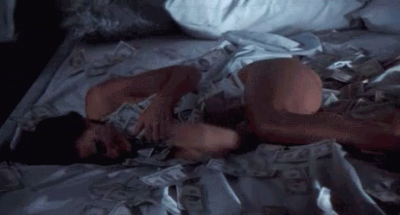
… and Demi Moore flinging off her top in Striptease (1996)
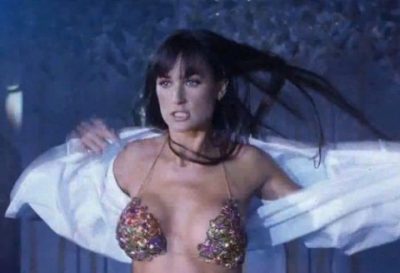
Both those movies were about the commodification of women’s bodies, and men’s various attempts to broker or control female sexuality, but both were better known as pop-culture talking points. The first movie introduced the dinner-party question: How much money would it take for you to sleep with a man who wasn’t your husband? The second movie — well, I didn’t see it, and I don’t know anyone who did, but we all watched the trailer. This was back when you had to watch commercials at the gunpoint of a DVR-less world, and I must have seen that Striptease trailer two dozen times. Demi Moore bursting onto the stage in that oversized man’s button down, ripping it open to reveal the jiggle of her (obviously enhanced) breasts barely contained by an encrusted gold bikini. She had this carnivorous look, like she was about to chomp into a turkey leg, but instead she swiveled around a pole, and the men in suits leapt to their feet and pumped their fists.
I was twenty-one years old. I stomped around my college campus in Doc Martens and enormous flannel shirts. My wardrobe was entirely the “before” shot in that Demi Moore strip tease. But the trailer suggested the men of my day were ready to see the women of my day rip off our frumpy men’s attire and reveal the thumping splendor of our fleshy feminine landscape — and over the next years, that’s exactly what happened. The late Nineties was an era of thongs, bikini waxes, crop tops, everyone started dressing like they were on MTV’s Spring Break. I was slow to catch this shift. Once I was passing through the mall with a guy I’d been dating when I pointed to the mannequins in the window display of Victoria’s Secret, wearing the comfy full-coverage cotton briefs I bought (five for $20), and I said, “Oh look, I wear that underwear too,” and he said, with a tone I recognized as sarcastic, “And they look just as sexy on those mannequins.”
Ouch. I was carrying about twenty extra pounds of beer bloat, and I spent much of my mental energy worrying about this. My thighs, my ass, my upper arms, my shins (my shins!). But I’d never worried about my underwear. Around this time, I was digging through that guy’s closet looking for something, and I came across a pair of bikini panties with pink rosebuds. I carried them with thumb and forefinger to the place where he stood, and he explained in a calm voice that a few months before we met, a woman he’d been seeing came to visit from New York, and she left those, and he wasn’t sure what to do with them now.
“You throw them away,” I said, and he tilted his head sideways, like maybe / maybe not. He thought he should mail them back, but he kept forgetting, and if this sounds like a sketchy excuse to hold on to a woman’s rosebud panties, then I am with you, but I wasn’t sure how mad I could or should be. I was trying to understand — how a man could want you, and want another woman at the same time. Was that sexual betrayal, or sexual nature? Men’s desire scared me. It seemed hydra-headed in an uncontainable way. One night, I got very drunk and very jealous at a wine tasting we went to together, where that guy spent the evening in deep conversation with a chic woman wearing one of those plunging dinner jackets that revealed the deep V of her torso, and later, when I made snippy comments about this, he informed me she was a lesbian. Oh.
But I didn’t like losing to anyone. I wanted to be the most fascinating and sexy and devastating woman in the room. And back then it felt like every room I entered had the equivalent of a Demi Moore ripping off her white button-down to reveal eye-popping assets, and being bested by these other women — in either the sexual or intellectual realm — made me feel small, and stumpy, and pointless, and I spent a lot of those years responding to this crisis of my own value by drinking too much or trying to make myself funnier, smarter, hotter, better. It worked, and it never worked at all. That guy ended up leaving me after six months, and the next woman he dated was a former stripper who worked at his restaurant. All my life I’d battled beauty queens and drill team captains and cheerleaders, the cliched version of the coveted woman, and now I had to battle with strippers, and they were world-weary and dark and cool, and it wasn’t fair.
I seem to have gone off-topic. Where was I going with this? Let me say it this way. I cannot separate any disapproval of stripping from my sense of failure that I didn’t have goods. Any critique I have of the profession must be considered alongside an envy that I was not one of those women. If my body had looked like Demi Moore’s, if I had needed the money — would I have learned the pole, too? I can’t tell you. It’s very easy to hold the moral high ground on stripping when you are well aware no club was ever going to hire you.
V
I actually cried in Hustlers. Not much, but a little bit, toward the end. It spoke to the part of me that feels a blistering need for male desire, but a powerlessness to control it or even leverage that attention to heal the blasted-out hole in me that needs filling. It spoke to the part of me that wants to care-take others, or can’t stop worrying about someone else, even after they’ve hurt me. Do men understand this? Am I being gender essentialist when I say this is a movie for women? (Is being gender essentialist really so bad?) I’m not saying men won’t like Hustlers, I’m saying if a man didn’t like it, I wouldn’t be surprised. The way nobody would be surprised if I didn’t like a sports movie, or some film about a botched military strike. I do like war movies, but some part of me disengages. Not my battle. Not my challenge. Not me. I often find the most boring part of a film to be the fighting, the car chase, the wordless conflict. Not long ago, I saw the latest Avengers movie, and I loved it, but I kept nodding off during the ridiculous twenty-minute fight sequence near the end. It was just visual white noise to me. But Hustlers kept me riveted. It’s not a virtuoso piece of filmmaking, but it had the texture of a story told right. Several former strippers have said as much.
Back when I was running the personal essays section at Salon, I got a number of essays from strippers. There was this one woman, mid-twenties, who wrote about her heroin addiction. She could turn a phrase, she had a pyrotechnic quality with language, she sent me a fascinating opening scene of nodding out on the pole. I wrote her back, we began a correspondence — about drugs, about women’s bodies, about sobriety, and why she wanted it, but fucking didn’t want it at all — and I told her this was the beginning of a great essay, but I was pretty sure she was going to have to get clean to write the rest of it. She told me maybe / maybe not, but she was going to try to write it un-sober anyway. Over the next two years, she wrote me about every four to six months, explaining why she hadn’t finished the piece, apologizing, wondering if I’d forgotten her (I never did), submitting versions that were drug-induced blather, chastising herself for not getting her shit together. I felt relief every time I saw her name in my inbox, because it meant she was still out there. She had not given up.
I lost my Salon email address when I left the job four years ago, so if she ever wrote me again, I would not know it. This bothers me — a stream of love, broken. I think about her from time to time, I wonder where she is, and on the off-chance she is reading this, please email me. You don’t have to write the rest of that essay. I just want to know you’re OK.
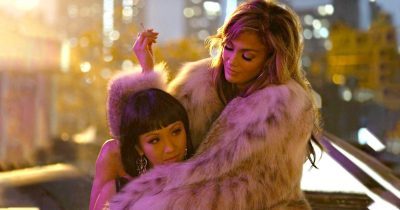
The post Five short stories about ‘Hustlers’ appeared first on Sarah Hepola.
September 8, 2019
Burn cigarettes
This morning I saw two people smoking on a back patio. The image startled me. Of course millions of people smoke old-fashioned cigarettes, I know this. But the ritual of the stolen smoke, the camaraderie of the picnic table — at 9:30am, no less — was like a frame lifted from an earlier era. As I walked to my car, a phrase lingered in my mind. Burn cigarettes.
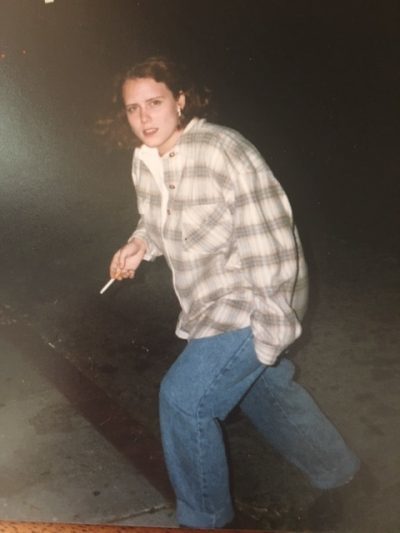
San Francisco. The Nineties.
I first heard the term “burn cigarettes” on an NPR segment about vaping. Maybe five years ago. The interview subject was trying to distinguish between traditional tobacco- and tar-based cigarettes and the next-gen vapor pens that were dominating the market. I liked the term. It sounded correct. Burn was the verb I associated most with that activity — the flinty scratch of the lighter, the crinkle of thin white paper at the end as I took a sharp inhale, the sensation of the smoke traveling into me, then back out of me in a tamed white line. It burned.
And I liked that burn, the flick of masochism, a scab tugged and pulled. I smoked on and off for twenty-five years, and when I was drinking, I loved it uncommonly, and when I wasn’t drinking, I hated it. Loathed the smell. Felt nauseated by the plume that erupted from my purse after a long night, shamed by the stink that hung in my clothes.
I had a habit of falling for men who lit up as soon as their feet hit the ground in the morning. I would see them on the back patio, boxers and bedhead as they sucked down that toxic cocktail, squinting as they stared into the sun, and I would think: No way. You could not pay me enough to smoke that early. But I liked how they did. Isn’t that weird? Maybe it made me feel superior. Not addicted. But I also thought they looked … cool? Those slouchy, grimacing men sucking down their Camel Light at 9am were an echo of the hot, smoking men whose images I’d absorbed into my bloodstream over decades, the kind of men I always wanted to wake up beside, the kind of men the men I was dating always wanted to be.
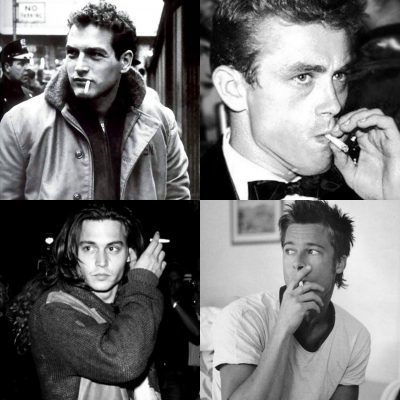
I quit drinking the same day I quit smoking. June 13, 2010. It will tell you something about the difference between those relationships that I wrote an entire book trying to release myself from the grip of one drug and I barely mentioned quitting the other drug to friends. People did a double take. You quit smoking, too? Eh, yeah, but I didn’t care. Without the booze, I never wanted the cigarettes. They were useless to me, a bunch of lousy match sticks. But I howled and howled about giving up the booze. I didn’t know how I’d carry on, I felt lost without it — all the heartbroken torch song cliches, that was me without my tumbler, without my pint glass, without my wine glass. The pack of Parliament Lights? Here, you can have it.
Cigarettes had become a pain by then. Expensive. A nuisance after the New York laws that outlawed them in bars. I’d find myself huddled on a fire escape with three strangers as snow pounded the pavement. Maybe it sounds exciting and reckless, but it felt stupid and pointless. I rarely think of cigarettes anymore. Every once in a while, I hear a woman with that delicious cigarette alto, the flinty scratch in her voice. Every once in a while, I miss the ritual. Not the high of nicotine so much as the meditation. The taking in, the breathing out, the invisible trajectory of oxygen given a splash of white. It’s too bad that cigarettes look so cool, because the act of smoking is quite stupid. Everyone knows this. Probably the best argument for smoking is that humans deserve to do stupid things. They will do stupid things in the face of all facts, they will do something simply because it is stupid.
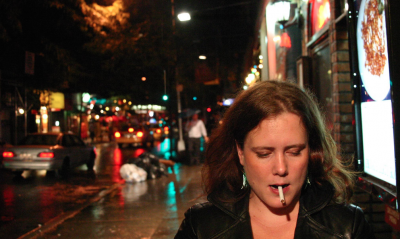
I got more compliments about this photo, taken at a NYC club in 2005 by my friend Tara Copp, than any professional shot ever taken of me.
A few years ago, I bought a vape pen. I brought it to dinner with friends as a novelty. I thought it would be funny. And then my friend, who hadn’t smoked in about a decade, proceeded to vape for the next several years. Whoops. I did not. Why did my friend start smoking again, and not me? How come nicotine is hellishly addictive, as addictive as heroin, and yet I smoked for twenty-five years, and quit in a finger snap? It doesn’t make sense. It’s not fair. This is true of most of life, by the way: It doesn’t make sense. It isn’t fair.
About two years ago, an old college friend showed up to a book event in Chicago. At the after-party, he tapped out a cigarette from his pack as we stood outside an art gallery. “I still smoke, I know it’s stupid,” he said, and I didn’t say anything. He’s married now, with kids. What am I going to tell him he doesn’t already know?
“Give me one,” I said, and he cut me a skeptical glance, but he handed one over, and the two of us stood on the curb, flicking our ashes in the empty street, the throb of the party inside making our cocoon feel even cozier. The camaraderie of the shared smoke — that might be what I miss most.
“Give me another,” I said, when I went outside with him about an hour later.
“No way,” he said. One cigarette was forgivable, but two was tempting fate.
“Come on,” I said. “Just one more.” Why? I hadn’t even liked the first one that much, but I felt the tug inside me. He tapped out the cigarette in a way that I would have to be the one to pluck it myself, and I smiled as I placed it in my mouth, and I felt the cinch of the white paper against my lip. I remember this, I thought, as I took the smoke down into my lungs and released it again, which always felt like a flirtation with the dark side, a do-si-do with the devil. I thought about the way, whenever I bought a new pack, I flipped over one cigarette. The lucky. Who started this? What was the point? I think the idea was that a cute boy might pluck that cigarette — and then, and then …
“You have to promise me you’re not gonna start smoking after this,” my friend said.
“I won’t smoke for like two years after this,” I said, exhaling a white line of smoke, and that night was two years ago, so I kept my promise. I am not so reckless anymore. I don’t even like cigarettes. But every once in a while, I miss it. Burn cigarettes. Even the words crinkle like paper set to flame.
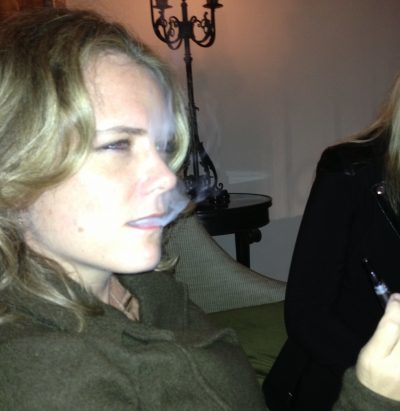
this is a vape pen
The post Burn cigarettes appeared first on Sarah Hepola.
August 21, 2019
Anxiety is the dizziness of freedom
I drove to Palo Duro Canyon, because I had to go somewhere, but I couldn’t go far. I was on deadline for my book, due in September, and the more extravagant trip I had envisioned — out to the northern rim of the Grand Canyon, the quieter and more profound side of the great gash in the continent — would take too long. Palo Duro was a six-hour drive from Dallas. I stumbled on a cabin on the website, and I called to see if it was available, and the woman said, “Those cabins are usually booked, but we just had a cancelation.” Boom. Like a romantic comedy or something.
I stopped by Cadillac Ranch on my way. I’d never been. Those cars have been upside down in the earth for forty-five years, much longer than they were ever on the road. They are mottled and drippy with stalactites of spray paint. I had a can of gold, and I tried to draw a cat’s face, but the wind was blowing the spray, so it came out a circular muddle. Let’s call it Jupiter. It was a wind-swept afternoon in late April, and kids scampered around, sat on the fins, very communal and pre-Instagram, like maybe visiting was more the point than documenting.
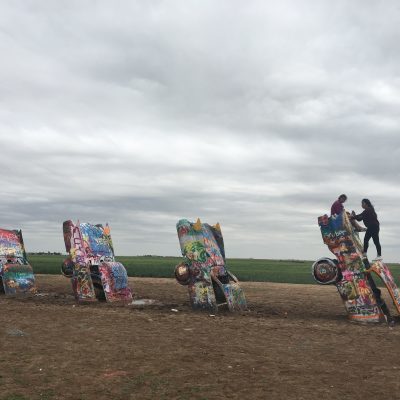
Cadillac Ranch
I checked in to the state park, got an old-fashioned key. The cabin was small and warm and built in the 1930s by men in the Civil Conservation Corps, part of the New Deal program, out-of-work men who probably did not imagine the place would be visited by a single woman traveling alone. Thank you anyway, gentlemen. The cabin looked directly onto the canyon, a marvel of compressed time, pink and grey and taupe. Time that can be seen. Pleistocene. Triassic. Permian. Time has stripes. (What will our stripe be?)
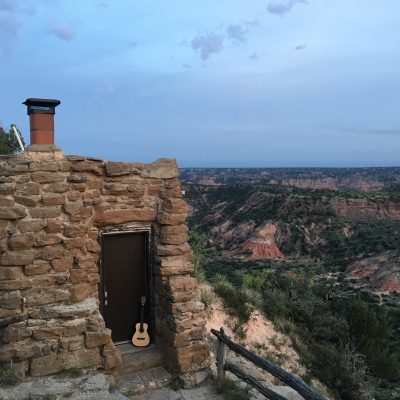
Lighthouse Cabin
It rained in the morning, bummer, and I sat inside typing, and when it cleared in the afternoon I took a hike to the Lighthouse hoodoo, a three-hour excursion along muddy rust-colored river beds. My socks and the bottoms of my trousers were wet from walking across shallow streams. I listened the John Mulaney interview on Fresh Air. True story: I once saw John Mulaney on the platform of the L train in Williamsburg, and I said to him, “You’re the funniest one on Best Week Ever!” and he said, “Oh, well, thanks.” And I was like: I wonder if we’re gonna date now. After that interview, I switched over to Philosophize This!, a podcast I’d been enjoying on the drive. The Mary Wollstonecraft episode. [whistle sound] Now that woman had a rough life.
The cabin smelled funny when I returned, like sour milk, or mildew. Maybe the rain had coaxed out a stink I hadn’t noticed when I was inside the place. I played my guitar, a Tom Waits song. The sun came out, and I walked out to my front porch and there were people at the cabin across the way, and they never waved. It was odd, stepping into the space across from them, and never acknowledging each other. I guess I never waved to them either.
I walked to the lookout point down a hill from my cabin. It was empty save for a guy leaning against the railing, and I walked past him onto a trail that wound along the rim until I found a flat spot near a ledge to take a seat and watch the sun sink. The sun was behind me, actually, I could see the golden halo on the other side, but the bottoms of the clouds took on sunset colors. Pink and a bit of purple. Nature’s Instagram filter.
Kierkegaard said, “Anxiety is the dizziness of freedom.” I thought about that line as I stared down into the canyon, felt the whoosh of the vertigo. I remember being a young girl, being freaked out by the awareness brought on by standing at the edge of a cliff: I could jump. I could end it! The power I had — to change fate with a slip of my foot. It startled me then, and still does. The birds were chirping, a low hoot that was maybe an owl. The thud of a truck door closing, the chug of its engine, and wheels grinding up the gravel as it disappeared. Alone now. I placed my hand in a baggy, and pulled out a handful of my cat’s ashes (she had died, and I had come to Palo Duro to let go of her), and I scattered the ashes across the cliff, and the wind whipped up to blow some of them back on me, as always seemed to happen in the movies. A Pablo Neruda line came to mind. I love the handful of earth you are. What else to say? She was my cat. She was a companion I didn’t know I needed, and now she was gone. Tears slipped off my chin. I scattered another handful across the rocky earth, and the ashes landed on a small spiky plant with purple buds on the tips.
I closed my eyes, and felt the breeze against my face, and I thought about how much smaller a woman’s life was once. That Mary Wollstonecraft podcast — I knew that stuff, but it was still an eye-opener, hearing the perimeter of that world. No education for women. Value mostly in your appearance, your docility, remaining quiet. A woman as property. A woman as helpmate, her purpose to lift up her husband, raise children, a satellite to the central body.
I am lucky to be here. How many people get to be here? By which I mean: The Lighthouse Cabin at Palo Duro canyon, two days of a spontaneous and silent retreat, but also in the midst of a book that someone will pay me to write. I didn’t get other things, but I got this. I looked down into the canyon at the paths snaking along the bottom, and wondered how they got there, whose feet made the grooves. I stood up, dusted off the seat of my tan trousers and walked back to the cabin and started packing to leave the next morning. Clothes folded into the green suitcase I’ve dragged around for the past ten years. The three-quarter scale Martin zipped back in the padded carrying case, and as I took it to the car I heard someone at the lookout now, singing into the canyon. He sang in that American Idol way. Melisma, I think it’s called. But the voice was clear and pretty and sincere, and it rang across the vast open space. I couldn’t make out every word, but I caught a few. Lord. God. Almighty.
I was worried about the book. I had four months before it was due, but I was way behind schedule, and I couldn’t puzzle out the structure, and I was fretting all the time. Like a Rubik’s Cube you are constantly trying to solve in your head. A book is nothing but choices. Go down this corridor? What about that stair way? You can drive yourself batty with the choices, all the paths you could carve through your own past. At some point, you have to say: This is how we’re going. I’m not entertaining other options any more. This way, and no other.
Night fell, and I stepped barefoot onto the stone walkway outside the door and found the stars in the sky so bright they seemed to be pulsing, sending messages to me: We’re here. Don’t forget us. A feeling of oneness shot through me. I’d been watching Cosmos, the Carl Sagan version: We are a way for the universe to know itself. We are made of star stuff. The canyon was dark and flat, and the sky took on a shape like a dome, like standing inside a planetarium. I found Orion’s Belt. I found the Big Dipper. I waved up to the beyond. I am here, too.
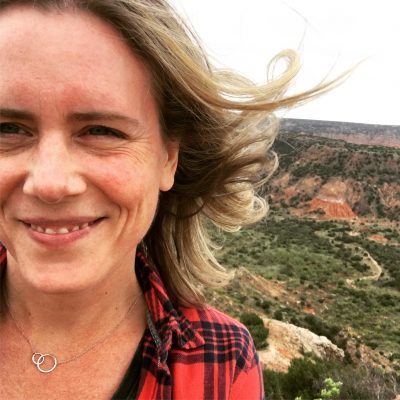
The post Anxiety is the dizziness of freedom appeared first on Sarah Hepola.
June 18, 2019
The Big Texan
I’m seated in a wooden booth with a vinyl tablecloth in a cow-hide pattern, and as my eyes trace the perimeter of the enormous banquet hall, I count twenty-six animal heads.
“What can I get ya?” My waitress wears a straw cowboy hat and a plaid Western snap shirt.
“I’ll have the chicken-fried steak,” I say, and without looking up from her notepad, she asks, “Mashed potatoes?” and I say, “Yes,” and she asks, “Cream gravy?” and I say, “Yes,” and she asks, “Garden salad?” and I pause for a moment — do I want a garden salad? — and then I say, “Yes,” and she asks, “Ranch?” and I say, “Yes!” feeling a bit exhilarated now, like I just watched her aim a rifle into the sky and blast three clay pigeons in a row. She snaps the end of her ball point pen and sheaths it in her front pocket.
“That was easy,” she says, and gives me a wink. The back pockets of her jeans are bedazzled in blue sequins.
The Big Texan is one of those Route 66 novelties in Amarillo, Texas. Billboards beckon drivers toward the place from hundreds of miles away: Home of the FREE 72 ounce steak. It was my friend Mary who recommended it to me when I told her I needed a place to stop in Amarillo.
“It’s like if Six Flags had a baby with the set of Hee-Haw,” she told me, and I was sold.
High on the wall across from me I see a series of clocks with large digital displays reading 60:00. A man in a ten-gallon hat says something into a microphone. He has the inaudible clip of an auctioneer. It’s only after the man stops talking that I finally notice: The countdown clock has started. And look: One brave man is seated at a long wooden table on an elevated platform. He looks like a lonely king, or a very tiny wedding party.
“Chicken-fried steak?” A different waitress slides my plate onto the cowhide vinyl. She is also wearing a straw hat, but she is much younger, a teenager, and she has dark braids falling along either shoulder. The plate is enormous — comically grandiose, which seems to be the signature — and it has a funny bit of garnish: a jalapeno with a tiny Texas flag stuck in it.
“Nice touch,” I say, pointing to the jalapeno, and she smiles.
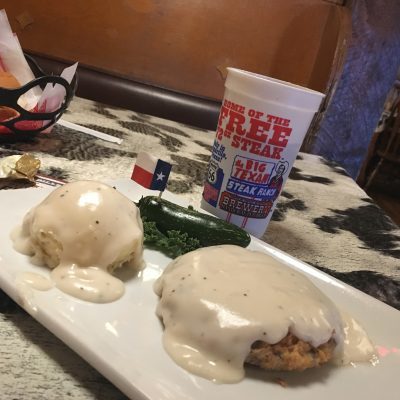
I watch the man plowing through his 72-ounce bad boy while I nibble on my chicken-fried steak. It’s like bouncing a a basketball on the floor while you’re watch an NBA game. The man is wearing a Hawaiian shirt. He is 35, maybe 40, with a trim beard. He sips from a straw rising out of a boot-shaped glass tinted pink. There is also a shrimp cocktail and a baked potato the size of a football on the table. Every once in a while, someone walks past him holding out their iPhone and he raises a fork with a piece of steak on it, then goes back to eating. The slab of beef is so ginormous it practically drips over the sides. A piece of beef the size of a road map.
An hour to eat that mess, or he owes $72.
Did he make it? How long did it take? Can someone Wikipedia this?
I wish I could tell you what happened, but I had to be on my way. I had another hour’s drive to reach Palo Duro Canyon before 3pm. I hate to leave you in the narrative lurch — but thus is the cliffhanger of the Big Texan 72-ounce FREE steak challenge, where heroes are made, heroes are broken, but no one leaves hungry.
I did keep one memento from my brief stop. My new lucky charm.
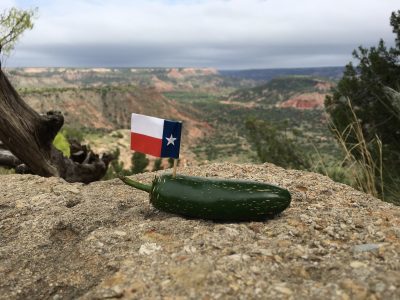
The post The Big Texan appeared first on Sarah Hepola.
Sarah Hepola's Blog
- Sarah Hepola's profile
- 328 followers



